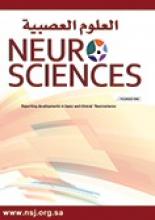Abstract
OBJECTIVE: Identification of the clinical spectrum and the electrophysiological responses of a Saudi population with Parkinson’s disease as opposed to a matched normal population.
METHODS: Fifty four subjects (41 males and 13 females) were selected for the study. The patients were clinically evaluated for the occurrence of Parkinson’s disease symptoms, as well as other associated medical conditions. All patients had brain computerized tomography scans. Electrophysiological tests were performed on all patients using the Medelec ST 10 Sensor 59394 Model. These tests included somatosensory evoked response of median nerves, brain stem auditory evoked responses and visual evoked responses. The significant differences in these evoked responses between the patients with Parkinson’s disease and normal patients were statistically evaluated.
RESULTS: Twenty six out of the 40 computerized tomography brain scans which had been carried out showed normal brain morphology and 5 had a clear evidence of cerebrovascular disease while only 9 showed distinctive brain atrophy. The mean values for the brain stem auditory evoked response, the somatosensory evoked response and the visual evoked responses were higher in patients with Parkinson’s disease as compared to those who did not have the disease. Significant differences were only seen as prolonged latencies in median nerve somatosensory evoked response, as well as delayed waves I and V on the brain stem auditory evoked response. Inter-wave latencies, however, were not significantly different.
CONCLUSION: Parkinson’s disease in a Saudi population showed significant differences to somatosensory evoked response and brain stem auditory evoked response electrophysiological data as compared to age-matched controls, however, the clinical characteristics of Parkinson’s disease in Saudi patients are not significantly different from those reported for patients elsewhere.
- Copyright: © Neurosciences
Neurosciences is an Open Access journal and articles published are distributed under the terms of the Creative Commons Attribution-NonCommercial License (CC BY-NC). Readers may copy, distribute, and display the work for non-commercial purposes with the proper citation of the original work.






